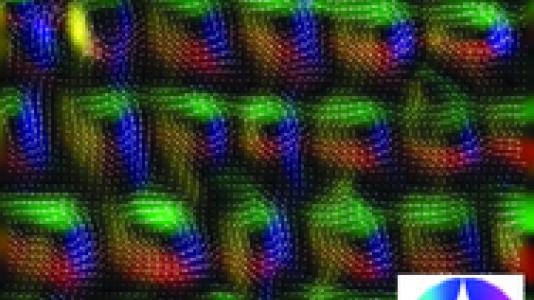
Scientific Achievement
Real space observation of nanoscale magnetic skyrmions in a ferromagnetic and ferroelastic material at room temperature, in the absence of chiral interactions and an external magnetic field.
Significance and Impact
Creation of magnetic skyrmions in multiferroic materials will enable their control through externally applied strain in conjunction with magnetic fields. This research offers novel insights into the creation of “designer magnetic materials systems” that can host magnetic skyrmions at room temperature for energy efficient technological applications.
High-Level Research Details
The magnetic spin texture in Ni49.9Mn28.3Ga21.8, which is ferromagnetic and ferroelastic, was analyzed using in-situ aberration-corrected Lorentz transmission electron microscopy (TEM). We showed the formation of a nanoscale skyrmion lattice that is stabilized by a balance between exchange, demagnetization and magnetocrystalline anisotropy energies.
Using in-situ TEM magnetizing experiments, we elucidated the deformation of the non-trivial skyrmions into trivial bubble domains under an applied field.
Additional Research Details
Magnetic skyrmions belong to a set of topologically non-trivial spin textures at the nanoscale that have received increased attention due to their emergent behavior and novel potential spintronic applications. Discovering materials systems that can host skyrmions at room temperature in the absence of an external magnetic field is of crucial importance, not only from a fundamental aspect, but also from a technological point of view. So far, observations of skyrmions in bulk metallic ferromagnets have been limited to low temperatures and to materials that exhibit strong chiral interactions. In this work, we show the formation of nanoscale skyrmions in a non-chiral multiferroic material that is ferromagnetic and ferroelastic, namely Ni2MnGa, at room temperature, without the presence of an external magnetic field.
By using aberration-corrected Lorentz transmission electron microscopy, we were able to elucidate the skyrmion formation as a result of geometric confinement of a magnetic spin texture into microstructural nanoscale twin boundaries. The magnetization forms zig-zag domain walls which deform smoothly to form a skyrmion lattice to minimize the exchange, demagnetization, and uniaxial anisotropy energies. We have also observed the formation of larger skyrmions (200 nm) in wider twin variants under an applied magnetic field. Using in-situ experiments coupled with micromagnetic simulations, we elucidated the deformation of skyrmions with skyrmion number 1 into a trivial bubble domain with skyrmion number 0.
Our results show that chiral interactions are not necessary for a material to host a skyrmion phase. A rich variety of magnetic interactions can be tailored to obtain a wider spectrum of complex magnetic spin textures. Furthermore, because Ni2MnGa is also ferroelastic, there is potential to control the skyrmion behavior using externally applied strain..
Research Team
Charudatta Phatak, Olle Heinonen, Amanda Petford-Long (Argonne Materials Science Division); Marc De Graef (Carnegie Mellon University)
Sponsors
Department of Energy, Office of Science, Basic Energy Sciences, Materials Science and Engineering Division
Reference
[1] C. Phatak, O. Heinonen, M. De Graef, A. Petford-Long, Nano Letters 16, 4141-4148 (2016) doi://10.1021/acs.nanolett.6b01011
Acknowledgements
Work by C.P., A.P.L., O.H. was supported by the U.S. Department of Energy, Office of Science, Basic Energy Sciences, Materials Sciences and Engineering Division. Use of the Center for Nanoscale Materials, an Office of Science user facility, was supported by the U.S. Department of Energy, Office of Science, Office of Basic Energy Sciences, under Contract No. DE-AC02- 06CH11357. M.DG acknowledges support from the National Science Foundation, grant # DMR-1306296. We gratefully acknowledge the computing resources provided on Blues and Fusion, high-performance computing clusters operated by the Laboratory Computing Resource Center at Argonne National Laboratory.
